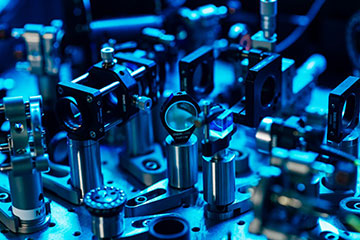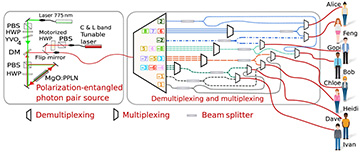
[Image: ÖAW/Klaus Pichler]
The security offered by quantum key distribution (QKD) is increasingly being exploited in real-world applications—in everything from vote counts in Switzerland to banking transactions in China. To date, however, the specific systems involved have largely been set up for two communicating parties only.
That could change thanks to work from a collaboration of scientists in the U.K., Austria, China and Croatia. The group has developed a networking scheme in which each user can exchange quantum keys with every other user on the network. The researchers demonstrated the new technology by setting up a network of eight users spread out across the city of Bristol in the U.K., and predict that it could eventually be scaled up to create a future quantum internet (Sci. Adv., 10.1126/sciadv.aba0959).
Doing away with trusted nodes
QKD harnesses the counterintuitive laws of quantum mechanics to allow two people—traditionally known as Alice and Bob—to exchange messages along a completely secure channel. It does so via the creation of secret keys composed of a series of bits that are encoded in the quantum properties of photons. Any eavesdropper attempting to intercept a key will reveal their presence by causing a noticeable change in the bit values.
Scientists have previously demonstrated QKD across metropolitan networks with limited numbers of users, in cities such as Tokyo, Vienna and Geneva. However, those networks relied on what are known as trusted nodes, which route key values from one user to the next by converting quantum information to classical information and back again. Not only do these nodes require significant amounts of hardware, but the way they handle encryption keys makes them potentially vulnerable to hackers.
The latest research, led by Siddarth Koduru Joshi of Bristol University, does away with trusted nodes by exploiting the strange phenomenon of entanglement. Described by Einstein as “spooky action at a distance,” this involves an intimate connection between two or more distant particles such that the result of measuring a certain property of one particle is instantaneously reflected in the others.
A new topology, city-wide
The new work is an adaptation of a scheme set out by some of the team members two years ago (Nature, doi: 10.1038/s41586-018-0766-y). As in that earlier incarnation, the present network exploits wavelength division multiplexing to distribute entangled pairs of photons from a single source to multiple users. However, it also uses beam splitters for additional multiplexing. This means that fewer wavelength channels are needed for a given number of users.
The physical topology of the Bristol team’s entanglement-enabled network. The use of both beamsplitters and multiplexing elements allows up to eight users to exchange quantum keys, using just 16 wavelength channels. [Image: Siddarth Koduru Joshi et al., Sci. Adv., doi: 10.1126/sciadv.aba0959 (2020); CC BY 4.0] [Enlarge image]
The overall topology of the network's hardware is straightforward—each user is simply connected to a central hub by a single length of fiber. The hub consists of a source of photons entangled in their polarization that feeds a series of multiplexers and beam splitters. Once the photons leave the hub and then emerge from a user's fiber they pass through another beam splitter, which directs them along one of two paths with equal probability—leading them to have their polarization measured using either of two nonorthogonal base pairs. With the result of that measurement registered by one of two single-photon detectors, secret keys are built up.
Users can share those keys with every other person on the network—while limiting the number of wavelength channels—thanks to the specific arrangement of multiplexers and beam splitters within the hub. The experiments carried out by Joshi and colleagues involved Alice, Bob and six other virtual users exchanging keys, yielding a total of 28 pairings. But they did so using just 16 different wavelengths. The 2018 arrangement, in contrast, would have required 56.
The researchers first tested the network inside a single laboratory within Bristol University's physics department, with each user connected to the central hub via a fiber just 10 meters long. Then they upped their game by moving to kilometer-scale links. Some of these they created by spooling fiber in the lab, whereas others they set up by incorporating pre-existing fiber links from other buildings in the city center.
In both cases, the researchers found, the rate of errors recorded by users was below the threshold for QKD and stable—crucial requirements for long-term operation.
Scaling up
Joshi is optimistic about the potential of this technology. Involving a linear scaling of detection hardware with the number of users, he reckons it could prove much cheaper than rival schemes. Indeed, he thinks it might be possible to build a network serving millions of users within the next 15 years—something akin to the quantum-mechanical version of today's internet.
Significant hurdles remain, however, before this vision can become reality. For one thing, a true globe-spanning quantum internet will require devices known as quantum repeaters that have yet to be fully developed. More specifically, Joshi and coworkers say, existing laser and multiplexing technology limits their current network to a few hundred channels at most. Speed too will need to increase—the city-wide experiment having achieved secure key rates as high as about 50 bits per second but as low as 0.5 bits per second, depending on the link in question.
Joshi points out that there are specific cryptographic schemes that can make do with such low key rates, but says that in the long term faster links will be needed. “The speed is not limited by anything fundamental,” he explains. “In most experiments, including ours, it is just a matter of cost.”

